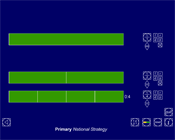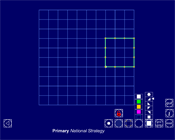Example review questions
- Circle the two fractions that have the same value.

- Which is the odd one out? Why?
6/10, 3/5, 18/20, 9/15
- Match each white box to the yellow box that has a number with the same value.

 Counting and understanding number
Counting and understanding number

This teaching guidance document suggests some of the key vocabulary, models, images and practical equipment that children should experience and be able to use. It also includes some teaching tips to provide a few starting points for ways of supporting children with this area of mathematics.
![]() Can I find simple equivalent fractions? - teaching guidance | 85KB
Can I find simple equivalent fractions? - teaching guidance | 85KB 
These resources are to support children in guided or independent work. Roll over the highlighted resources for a description.

This interactive teaching program (ITP) is an ICT-based tool to support the exploration of part numbers. Fractions ITP allows the child or teacher to represent and compare fractions on fraction strips. The displayed strips can be labelled as a vulgar fraction, a decimal fraction (to three decimal places) or a percentage, and the ratio of yellow to green parts of each strip can also be displayed.

This interactive teaching program (ITP) is an ICT-based tool to support the exploration of number, shape and space and problem solving. Area ITP (version 2.2) allows the child or teacher to place counters or colour in whole or part cells on a grid, pinboard or blank screen, or to define a shape using an elastic band.
Possible contexts include:
Ask probing questions such as: